Material Potential-Vortices
By increasing speed and shorter radius, the centrifugal forces become stronger. A border comes up, where the potential-vortex changes into a rigid vortex. At that inner area (dark green) all is rotating by likely angle-speed. So towards inside, the absolute speed of particles decreases, like marked at C.
At D some particles from inside outward are drawn. At center of vortex the particles (grey) move as a rigid vortex (like a wheel). Towards outside the particles come ahead slower and slower (marked by different red colours). The outside particles stay behind general turning motion more and more (see positions E and then F).
At picture 08.17.02 that motion pattern is sketched as a ´shoal of fish´, where outside fishes are swimming slow and are overtaken by faster fishes further inside. Following animation shows the characteristic of a potential-vortex by some moving pictures. Each natural water-vortex is moving in shape of that motion pattern. That steady ´overtaking´ demands water-particles gliding alongside each other. Based on the resulting friction, the laminar border-faces are replaced by multiple narrow vortices-files or twisted threads of water motions.
Particles of gases are not steady close to each other, but are mutually colliding permanently. The vortices of a tornado or even of small whirlwinds are self-accelerating, because static pressure of environment passes into dynamic pressure of rotating motion (described in details by fluid-technology at parts 05., 06. and 07. of that Aether-Physics).
Swinging Aether-Disc
At picture 08.17.03 at A is sketched, how neighbouring aether-points (marked by red curve) are swinging at circles parallel to each other within space. The radius of swinging can become wider, like sketched at B. There an aether-point C (black) momentary is at its lowest position.
If anywhere the aether did move down, anywhere aside the aether must move up for balancing the total volume of aether. Because aether is gapless and not elastic, all times that compensation of motions is necessary (here marked by dotted arrows E). Also right side the aether is swinging likely, however shifted by 180 degree. So the aether-point D momentary is at its uppermost position and also its neighbours are upside at the blue curve.
The green area upside at picture represents a longitudinal cross sectional view through a vortex-disc. Around its center, many of these double-crank-vortices are arranged radial, resulting a round vortex-face. Both green areas below at picture represent cross-sectional view through that vortex-disc respective a view onto that face.
One double-crank is highlighted by red and blue curve. An aether-point F (black) momentary is located below 9-o´clock-position. All cranks are turning synchronous around their axis, which each are showing into radial direction. At picture below right side, situation is shown where crank has turned by 180 degree. Previous aether-point now is located at G, i.e. some upside of 9-o´clock-position. All points are swinging likely. So the disc as a whole is alternately moving some left- and afterward some right-turning (see double-arrow H).
All distances between aether-points keep constant - as necessary within gapless aether. Even that aether is an absolute ´rigid stiff substance´ (comparable with ´solid body´), the aether is internal moving by such motion pattern. Just as neighbouring aether-points must behave adequate, automatic must come up such areas of well ordered motions - and must run on and on.
Swing with Stroke
If both turnings are likely sense and likely revolutions, previous aether-point A is some outside of green circle-surface at its 3-o´clock-position and some inside at 9-o´clock-position B. Previous round green circle track becomes deformed in shape of an ´apple-track´, like downside right once more is marked by blue section C and red section D of that track.
Upside right these two different sections once more are drawn. Within blue section E the aether-point is moving relative slow and is running only short distance while six time-units. Again during six time-units, the aether-point within red section F is much faster and running further ahead in turning sense. Like described in details at chapter ´08.08. Tracks with Stroke´, such overlays result an irregular process of motions. Inevitably comes up a ´beating´ motion component.
Swinging to and fro
At B are drawn connecting lines of neighbouring aether-points from center to the border of vortex-disc. These curves result of parallel swinging at each different radius: outside at narrow tracks, further inside at increasing wider tracks-with-stroke, towards the center again by very small radius. Left side at B, the motion of slow segment (blue) schematic is sketched, where the aether-points take much time for back-swinging (in turning sense of system).
Right side at C, opposite the motion of fast sector (red) is sketched, where aether-points do likely distance much faster by its left-turning beating-ahead. Below at D the difference of the strokes are marked by curve (above dark-red face): at border of vortex-disc practically null (neutral Free Aether), further inside increasing (like at any potential-vortex), finally towards the center again decreasing (like at usual rigid vortices).
At following animation, that swinging is shown by connecting lines in four radial directions: the neighbouring aether-points (red curve) are swinging fast forward, resulting a left-turning stroke within vortex-disc. Afterward, the same connecting line (now marked blue) is swinging back much slower as a right-turning motion within vortex-disc.
Previous pictures are extremely overdrawn: the vortex-disc of earth has a radius of about one million kilometer. Previous sketched radius R1 of a circled aether-motion might be ´one thousand millionth part of nanometer´ (just to name a number). The eccentric overlay of previous radius R2 might be smaller by millions. So each stroke realiter is minimum small. However all aether is swinging at least by light-speed, so that nearby subtle stroke occurs by high frequencies. So realiter there is no wide-reaching aether-swinging, an aether-´whirlpool´ really exists only by tiny uneven motions of (generally) stationary aether. Nevertheless that minimum beating well results ´material´ effects of macroscopic size.
Thrust onto Atoms
At picture 08.17.07 at A, schematic is sketched an atom. It exists by radial arranged vortices, here only one of these ´double-cranks´ is drawn. At center all vortices meet and all motions must coordinate synchronous within that narrow space. The ´bend-facility´ of aether there is maximum strained - and that´s the only reason why atoms and especially their core seem to be ´hard particles´. However there are no particles at all, because all is only build by that unique aether. These special motion-pattern of atoms are compressed to vortices-spheres by general aether-pressure (see arrows B) of environment (details please see chapter ´Aether-Model of Atoms´).
As soon as beat of ambient aether becomes weaker and finally ends, general aether pressure pushes back the bump below (see arrows F) and the atom comes back to its original sphere-shape. However now that vortex-complex G is shifted within space a short distance, i.e. the atom did ´tremble-ahead´ little bit into direction of the stoke, here thus was pushed some upward.
Once more the difference between seaming motion of material parts and real aether-motions is expressed clearly: only the motion pattern of atoms are shifted forward within space. All aether stays generally within its local ´frame of motion´. The aether within wide whirlpool is swinging just normal within space, only overlaid by previous beating motion-component. Occasionally the motion-pattern of an atom is pushed through a local area of aether. The aether there thus takes only temporary the motion pattern of an atom - and afterward behaves just like before.
Nothing else happens within aether - even it looks like gigantic planets would race through space. Planets exist by atoms. Atoms are no particles, they are only vortices of different complexity and thus are different ´bulky´ against changes (what commonly is called the ´mass´). Finally all is nothing else than motion of aether within aether, however locally by different swinging pattern.
Asteroid at opposite Course
At picture 08.17.08 the blue faces represent the space respective Free Aether and the green faces represent left-turning discs of an aether-whirlpool. When objects (black points) from outside fly into that area, the stroke of aether affects their tracks (black curves). It´s marked by red colour at which section from which side a thrust comes up onto the atoms of these bodies.
The earth is left-turning around the sun and also its aether-environment shows that left-turning beat. The objects coming towards the earth from the frontside (thus right-turning relative to sun) will show previous tracks. From the border of earth-whirlpool to the magnetopause (where local gravity of earth finally starts) e.g. an asteroid will move at tracks like marked at A and B.
Comets passing by
At this picture right side, previous objects enter the whirlpool of earth by likely angles, now however from the opposite direction: from backward with high speed (faster than the earth is turning around the sun). Previous comets thus now come from position G and H and enter the whirlpool into direction of its turning sense. Both again will fly at S-shaped tracks and pass the earth e.g. at distances of a half or one million kilometer (thus far the earth-whirlpool is working).
At E is sketched how an asteroid might enter contrary to turning sense by acute angle and finally will fall radial towards the earth (where left side the comparable asteroid enters radial and finally falls down diagonal).
No Parabolic-Flight
Starting position at F corresponds to previous at B, however now the object flies into the whirlpool by its turning sense. At first the track F is pushed some towards right (based on thrust from left, marked red). The object is guided into a circle in turning sense of beating aether-movements. If the speed of object is too fast, it wanders outward according to its inertia. At this opening spiral track (or even straight tangential track) now the beat comes from right side, i.e. the thrust affect from rear-aside (see second red section). Thus the flight is redirected towards left, until finally the object will leave the whirlpool.
In principle, again a S-shaped track comes up, here only some more twisted around the vortex-center. Never will result the parabolic-tracks as calculated by common formula. For each comet the track must be measured new, with differing results. The previous mentioned operations of ´gravity-sling´ did show without any doubts, the departure-speed is faster (and in some constellations also slower) than calculated - and nobody knows why. I guess also the direction does not fit (because in addition mostly the course must be controlled some later). One also wonders why satellites leaving the sun-system became faster or slower - when flying through supposed ´empty space´.
Naturally I state these ´outrageous´ claims without real data for approval. I only can recommend to check the tracks of objects not by rigid astro-mechanics but by view of aether-whirlpools. For specialists, lots of cases and data and facilities are available. If the tracks would be designed by that view - e.g. the flights to Mars could score better.
Roundabout of Ecliptic
Afterward, the object flies into tangential direction for some time. Next, the sideward push from outside presses the track back into turning sense of system. That follow of relative straight outward showing sections and more inward-bended sections can repeat (like here e.g. shown four times).
Right side at this picture an object B is drawn. Its track moves around the vortex-center, however not at exact circle. Again and again the object flies some outward, based on its inertia. The wider the angle to tangential direction of beating aethers is growing, the more the object is pushed inward again by that sideward thrust.
The speed of object can vary based on different causes. The curvature of track is variable and thus also the centrifugal forces. The aether-strokes in turning sense of system are not perfect steady. In general that push decreases towards the border of vortex-system. Finally when all these factors are balanced as a whole, the track of object will come close to a circle with an adequate radius.
At the other hand now it´s obvious, why planets never can fly around sun at exact circles. Also the tracks can not be perfect ellipses, even not symmetrical ovals - because too much factors determine the actual track. The planets fly on eccentric tracks which however must not be really closed. ´Rosette-pattern´ come up or outward- and inward-curved spirals. For example the distance between earth and moon changes regular within one month, in addition the moon flies off for eight years and comes back the following eight years.
The mathematical formula of ´laws of celestial mechanics´ can not really match all these facts. These formula just do not correspond to the affecting principle: consciously these previous pictures did not show any central mass (of sun or of earth), the tracks of these objects need no attracting force anyway, but exclusive are based on the stroke-components of aether-movements in turning sense of these whirlpools.
Worlds in Collision
That situation came up when the earth was overtaken by faster Venus at distance too narrow. The green point E represents the earth which is moving upward. Only a part of its aether-whirlpool is marked green with its left-turning strokes (see arrows). The red point V left side represents the Venus, the red sector marks a part of surrounding whirlpool. Within the crossing-area C (here marked only by coarse green-red pattern) the aether was in extreme tumult.
Myths and legends, holy books and old scripts from all parts of the world report about celestial fights, where ´gods´ in shape of comets, planets and stars are involved. So it´s told for example, a comet (Ishtar, Phaethon, Quetzal-cohuatl) did meet the earth several times until it was ´born´ as morning- and evening-star. So this comet swiveled into a narrow track, still turning around sun as the well known planet Venus. This meeting had disastrous effects for the earth - and for mankind - some few thousand years ago.
Catastrophe-Reports
Like this and even more confusing are these stories and one could neglect the event as exuberant fantasies - if the stories would not correspond by many details all over the world. Some survived that catastrophe, however following children and grandchildren did not know about, but grow up at a world just normal for them. What would the elders tell their descendants: fantastic web of lies or truthful reports of their extreme experiences? For lack of own experiences, following generations distorted the reports corresponding to momentary dominant culture. Two hundred generations later a new civilization - of our time - has achieved so much scientific approved knowledge, so most people no longer pay attention to such fairy tails.
Physical Reality
At Sahara existed extended lakes of fresh water, which suddenly flowed off into the sea. Everywhere exist strong stone-layers which never could be build so homogenous during millions of years. However a ´mush´ of water and sands is extremely liquid and at the other hand can grow stiff in short time by great heat. These ´stony witnesses´ are glaring - only mainstream-sciences turn a blind eye to, because otherwise to much common ideas should be revised.
An other fix idea of science concerns gravity and heavy masses, i.e. assuming masses mutually are attracting and all atoms are ´weighty´. Atoms have no weight but exist by normal aether like all environment too. These special motion-pattern ´float´ within aether respective tremble and race by incredible speed all around. Each air-particle flies from a collision to the next by 550 m/s equal 2000 km/h - and we don´t feel it. Everything is pressed towards earth-surface only based on gradual differences of local aether-movements (see previous chapter) - and we merely notice that. Same time we wander through space with the ecliptic and rotate within the whirlpool of earth - and are not bothered about.
During the meeting with Venus existed extreme aether-movements. The earth did a ´volte´ and was shifted outward within ecliptic by two million kilometer (about the diameter of earth-whirlpool). Instead of 360 days now one revolution takes about five days longer. How could people survive that process, why were they not pushed up through the air or pressed down to the ground by strongest forces?
Aether-Vortices within Aether-Swirl
All atoms are only some compounds of vortices of aether within aether. If ambient aether does not swing only neutral but shows a stoke-component into certain direction, the atom-motion-pattern are pushed ahead little bit (like mentioned upside). At that catastrophe all aether was most strong trembling - and into direction of major strong stokes all atoms were pushed forward within space, all atoms of man and all atoms (at least) of near environment. All aether did behave similar, so no relative-motion between man and ground existed.
Birth of new Vortex-Compounds
All atoms have a special aura, reaching far outside into the environment. If previous unsorted motion-fragments enter areas of such already existing motion-pattern, they will arrange accordingly (see subject ´Information, Resonance, Emergence´ of previous chapter). As at these times unusually many and diverse motions whirred through the aether, many fragments could form motion-pattern analogue to already existing ones. So an inflationary generation e.g. of previous elements H, C and O came up. These atoms were build new, however not from ´nothing´ but from the huge source of different aether-motion-fragments, which now only did arrange according to already existing aura-pattern.
H and O could burn to H2O - and ´new´ water did fall from heaven by buckets and for weeks. This might seem incredible, however also today, by certain conditions, it´s raining more water than given clouds could have stored by steam or ice. Even less credible are the stories telling ´manna´ would have fallen from heaven - however new H and new C, by certain and these extreme circumstances, well can build hydrocarbons - so nourishing organic substances.
As mentioned: enlightened people must not believe in these fairy tails. I only want to show the background where such incredible processes well could occur - because without existence of gapless aether as basis of all appearances, also these stories never could report about real events.
At the other hand it´s astonishing, just at these days thousands of scientists are amazed, because at CERN ´millions of new particles´ are produced. They hope to find the ´Higgs-particle´ because without that ´glue´ total construction of incomprehensible quantum-theories will vanish into the air. They also dream to find better understanding of ´big bang´ - which is based on insubstantial factors. These most destructive experiments are just the reversal of previous processes: intact vortex-complexes are crashed and garbage in shape of labile motion-fragments are resulting - with no chance for insight.
Track of Earth-Moon-System
Also the speed of earth varies (between 29.29 and 30.29 km/s). As an average the earth is moving forward each month (of 29.5 days) by about 75.8 Mkm into turning sense of system (see green marked sector A) respective about 37.9 Mkm between new moon and full moon (see green sector B).
At waxing half-moon the moon (black point) is positioned behind (in turning sense) the earth (blue point). Two weeks later the half-moon in the wane is positioned in front of the earth. The moon is ´outside overtaking´ the earth and at this phase is running about 0.8 Mkm longer distance. The moon is ´inside falling-back´ during the second half of month and there is moving about 0.8 Mkm shorter distance.
So the moon moves within space the long distance of about 38.7 Mkm (see broad red section C) during the ´full-moon half-month´. The ´new-moon half-month´ takes likely time, however the moon wanders through space only the short distance of about 37.1 Mkm (see small blue section D).
Thus the moon is not only turning steady around the earth, but meanders within space at its track around sun. At the one hand the moon is moving accelerated at a wide track (sector E) and at the other hand is moving with delay at a track more narrow to the sun (sector F). These phases alternate and in addition, also the earth is moving at irregular track sometimes faster and sometimes some slower.
It´s really incredible how that ´celestial mechanism´ could function based on common idea of ´imaginary attracting forces´. Either the moon must fly off (see arrow G, by its maximum speed and largest distance) or must fall towards the sun (see arrow H, by its weakest centrifugal force and minimum distance). Each mechanic knows the result of rotating systems with minimum eccentic data - which here exist by size of percents.
However also the alternative ideas of gravity, resulting of any pressing-forces or even of ´gravity-waves´ racing through the space, can not explain that motion process. These multiple variable respective ´flowing´ motions are only to understand as vortices-system: at the one hand of whole galaxy, within which the ecliptic rotates as a border-vortex, and again within are turning the ´whirlpools´ of planets. The aether is moving like a liquid with multiple embedded vortices. However, like the far-running see-waves are really only based on a local swinging of ´stationary´ water, so realiter also within space exist no far-running motions but only the local similar stroke-components of minimum small aether-movements.
Aether-Whirl-Wind of Earth
The earth (blue) is a massive ´dust-particle´ with radius of 6378 km (from earth center EZ to earth-surface EO at the equator). The earth does one revolution during about 24 hours, a place at equator is running at its circle track by about 1670 km/h, so just about one half kilometer each second.
An other massive dust-particle is the moon M, which turns around the earth at average height of about 384 400 km. The moon is moving forward by average of 3681 km/h respective about one kilometer each second. A full revolution takes 27.3 days, thus about 655 hours (and as the system meanwhile did wander within space, the moon must turn some further on to reach similar position, so one month takes about 29.5 days). Thus the moon does rather few revolutions, opposite to fast rotating earth at the center of the aether-vortex.
Artificial ´dust-particles´ with revolution just according to the earth are satellites S at geostationary track (GS). At height of about 35 800 km above the equator they are turning synchronous with the earth. They must be installed with a speed above 11 000 km/h respective 3.07 km/s. Then they are drifting there within the ´aether-wind´, without demanding artificial drive, just like the moon further outside does.
Left side of picture, the different speeds are shown by a graph (however not true to scale): from earth-center up to height of geostationary satellites the speed increases linear, as the aether-movements build a rigid vortex (SW, marked grey). Further outside, the stroke-component becomes weaker and correspondingly the ´aether-wind´ represents a potential-vortex (PW, marked red).
Some further outside of geostationary height, the ´winds´ could blow even some stronger (for example up to the magnetopause at height of about 60 000 km), and outside decreasing. From these 3 km/s at height of 35 800 km remains only 1 km/s at 384 400 km height of moon. If speeds would decrease linear, the border of vortex WG would not be far away. However the beating of aether is reduced hyperbolic, so the radius of total earth-vortex-complex will be approximately one million kilometer. That huge disc of ordered aether-movement represents the ´mass´ respective ´kinetic energy´ of the earth-whirlpool - thus infinitive more than these few ´dust particles´ drifting within.
Whirl within Whirl
Embedded within that sun-vortex is the ´earth-vortex-wind´ (EW, light green), also left-turning, also as a potential-vortex. At area of moon (M, grey/black) its speed is about 1 km/s. The moon thus is moving within space at the sun-side section of track only with some 29 km/s, at its outside section however up to 31 km/s.
Out there, both ´flows´ add, while these ´winds´ at sun-side show contrary directions. The stroke-motions overlay within the aether. As they are not anywhere completely in same phase, the weaker wind goes at an ´swerve-track´. That´s why the plane of moon is declined by about five degree relative to plane of ecliptic. Below at this picture schematic is sketched a cross-sectional view: the plane of sun-vortex (SW, yellow) is drawn horizontal, the plane of earth-vortex (EW, green) some diagonal.
As the earth-axis is inclined relative to ecliptic, depending on seasons, the sun is some higher or lower at the sky. Based on additional inclination of moon-track, the moon moves even higher or lower over the sky, each by monthly phases.
Differing Sections of Moon-Track
At new moon NM the vector of earth-vortex EW show contrary to (here upward showing) ´flow´ of sun-vortex SW. The track of moon is pressed inward (towards the earth), like marked by arrow A (naturally overdrawn).
At waxing moon ZM the moon at first flies cross to general flow, afterward becomes accelerated into direction of this flow. At this phase, the moon comes forward within space rather long distance, like marked by arrow B. Also from the position of full-moon VM the track is pushed some forward. The arrow C thus ends outside of comparable section of circled track. When the moon AM is in the wane, the flight at first crosses the general flow. Its track is extended outside of blue circle section, like marked by arrow D.
The speed of earth (and thus also of the flow of sun-vortex SW at this radius) is determined with minimum 29.29, average 29.78 and maximum 30.29 km/s. The moon (and thus the speed of earth-vortex EW at this radius) is determined with minimum 0.96, average 1.02 and maximum 1.08 km/s. So the moon is drifting through space by speeds between 28.33 up to 31.37 km/s. The speed thus varies by plus/minus six percent.
Un-even Vortex
Opposite to air, the gapless aether can not show any differences of density and based on its homogeneity also its beating motion-components must occur almost synchronous within whole earth-whirlpool (towards outside generally by weaker strokes). However also within the vortex-disc that beat locally can show different intensity (analogue to previous weather-fronts).
This aether-vortex is only visible by motions of the moon, which is drifting within that flow. The moon offers a surface of interaction for the flow, at the other hand the aether-movements are affected by the inertia of that large assembly of atoms. The moon at first resists the acceleration at previous phase of waxing moon, until the full moon achieves maximum forward-speed. At the other hand, the wane-moon at first has an ´oversize´ speed and based on inertia the following deceleration occurs with some delay.
The moon practically behaves like a piece of wood within water. At the one hand it´s drifting with the water-flow purly passive, at the other hand it has influence onto changing speeds or changing directions of water-movements. Just like this, the aether-movements are affecting the motion of moon and at the other hand the moon´s inertia reduces or enforces the aether-flows. At this picture below right side, schematic is marked how ´bow-waves´ come up in front and behind and aside of moon. Like at previous example of weather-fronts, the moon indicates especially ´turbulent´ areas. The whole earth-aether-vortex is not turning totally consistently all around, but especially intensive aether-motions are swinging around the earth, each in direction of momentary position of moon and each with some ´delay´.
In general, the moon at sun-side (new moon) is turning most slow, relative to the earth and also relative to the sun, so there is moving by minimum speed within space. At its outer section of track, the moon is turning most fast around the earth and also around the sun, thus is moving by maximum speed through the space (see arrows F and G).
Different Speeds
At the second row are marked the minimum and maximum speeds of moon with 0.96 km/s and 1.08 km/s. If that difference of plus/minus 6 percent is applied to motion of satellites, these will fly at the sun-side with slow 2.89 km/s and at the night-side by fast 3.25 km/s. Apart from these extreme numbers, the moon at its slow phase (at new moon) in average will move by about 0.99 km/s and during its fast phase (at full moon) by about 1.05 km/s. Corresponding middle numbers for the satellites would result speeds of 2.98 km/s and 3.16 km/s (see third row).
Because geostationary satellites are turning just as fast like earth-surface, the aether between must behave as a rigid vortex. So theoretic one can reduce linear the speeds of satellites down to speeds near earth-radius. The aether near earth-surface thus would drive at sun-side by speeds of 0.430 to 0.445 km/s and at the night-side with 0.475 to 0.490 km/s (as extreme and middle numbers).
Below at this picture these speeds are marked by a graph. From each geostationary track towards outside, the aether-motions build a potential-vortex with hyperbolic decreasing ´aether-wind´ (red marked face). From that satellite-height inward exists the rigid vortex (grey face) with steady decreasing speeds. The earth is a solid body and is turning steady, at the equator by these 0.46 km/s. Between earth-surface and surrounding aether thus exists a theoretic difference of 15 to 30 m/s. At the sun-side the earth is turning too fast and at the night-side the earth is too slow opposite to neighbouring aether. So there theoretic one should feel a relative flows of about 15 to 30 m/s, roundabout 50 to 100 km/h. Is that the ´aether-wind´ - which Michelson/Morley wanted to measure?
Michelson / Morley
In 1881 / 1887 Michelson and Morley made well known experiments for approval of that aether: they mirrored light-rays cross- and long-wise, into and opposite to direction of earth movements, all seasons long. As the sun flies around the sun by about 30 km/s, it was expected the light would show a difference of 60 km/s. Measured however were only 8.8 km/s, thus a number much too small. Also up to 1926 resulted speed-values of only 7.5 to 10 km/s. That´s why commonly still is talked about a null-result of these experiments and thus the non-existence of aether would be approved.
In 1978, Brillet and Hall made improved experiments with lasers at turnable units. They achieved much smaller differences of 16 m/s +/- 20 m/s - astonishing adequate to previous theoretical wind-differences of about 15 to 30 m/s. At the other hand resulted also speed differences of 190 m/s, which could interfere with the 960 m/s turning-speed of earth around sun plus these 460 m/s of earth own rotation - plus some galactic winds? Most interesting is the fact, they measured each two minimum and maximum, cross to each other (see below).
Without any doubt the light is moving by different speed within different media respective light is broken or curved (see e.g. chapter ´04.03 Light-Aether´). Where ever the aether is not quite neutral, e.g. within the wide whirlpools of planets, the light is affected by the local dominant beating of aether. Much farer than the atmosphere and local gravity of celestial bodies reaches, the light-rays interfere with the whirlpool´s motions. For example it´s especially obvious by Venus-transits. The contours become blurred and build ´drops´ when the Venus comes near the edge of sun-disc. Also when the Venus already left the sun-border, the contours still are merged for some time. So it´s quite sure the light will also show variable speed and direction when crossing the area of earth-aether-vortex.
As a whole however the previous experiments are based on totally false prerequisites: they assume existence of material at the one hand, and at the other hand of any kind of aether. So common assumption still is, ´solid particles´ (earth or photons) would have to move through the aether. Finally with this Aether-Physics it´s clear stated, there is no real existing materia but exclusively the gapless aether is real substance and - decisive fact - only the pattern of individual motions wander through the space. For approval of that aether one must not do experiments but many concrete clues are available, e.g. the movements of water and air, and as ultimatum evidence the ´unlawful acting´ of satellites which actually should ´stand still´.
Tides
At picture 08.17.16 upside is shown an official graph with the deviations above ´sea-chart-level´ (the absolute lowest water height, see blue line NW). Upside are marked the moon-phases of June 1955 with the new moon NM, waxing moon ZM, full moon VM and wane-moon AM. Every day come up two tides, the lowest water of each tide at night-time is marked by red curve.
Dammed up and pushed forward
There again are drawn the calendrical symbols for moon-phases (NM, ZM, VM and AM). The sun is positioned far upside of picture, the ´sun-wind´ SW pushes the earth E from left towards right side (here simply marked by straight blue track E). The aether-vortex around the earth is left-turning (here only once marked as light-green circle-face). The moon swings around the earth and once is positioned near to sun (upside, at new moon NM) and once at its outer section of track (below, at full moon VM).
At new moon the vectors of sun-wind SW and earth-wind EW are opposite directed, so the moon is slowly moving forward. As mentioned upside, the process is delayed by mass-inertia of moon and thus a ´bow-wave´ (marked dark-green) comes up. This wave of intensive deceleration arrives at the earth-surface finally nearby waxing moon ZM, resulting that ´spring-delay´ SV.
At the following phase the vectors of sun-vortex SW and earth-vortex EW show into likely direction, so the full moon VM is accelerated flying forward. However also here, the moon achieves its maximum speed some later, so its intensive ´bow-wave´ comes to the earth three or four days later (i.e. that wave wanders sideward by about 1 km/s). Finally after that spring-delay SV the swinging of water-level comes to its maximum.
So the moon well has influence - not by attraction forces but by controlling the intensity of aether-strokes within earth-whirlpool. By moon´s inertia at the deceleration-phase (at sun-side) like at acceleration-phase (at night-side) the unsymmetrical swinging within whole earth-vortex-disc becomes amplified (month by month, since hundred, thousand or millions of years). So the position of moon indicates where momentary most intensive motions exist (upside called ´bow-wave´). The earth is turning every day through these both areas of different fast respective intensive aether-motions. These variation of aether motions are affecting the earth as a whole and its most mobile masses, the waters of oceans, follow these changes.
Too slow and too fast
Gravity is affecting by that sense, the build-up water-hills afterward are pressed flat and are swinging down below medium water-level. Resulting are the tide-flows. The water thus does not only swing in vertical but also in horizontal directions. Previous differences of 15 to 30 m/s are theoretical numbers, the real aether-wind near earth-surface might blow stronger or weaker. Generally however that process is the real cause for appearance of tides, concerning the temporary course and concerning the different characteristics of the high and low tide, twice every day, all around the world.
Jet-Streams
The strength of previous tide-flows is strongly depending on regional different geology (see Canal). Within the air, local differences of pressure and temperature have even stronger affect for the air-motions. The jet-streams often are accompanied by high- and low-pressure-areas below. However these ´normal´ weather-appearances near earth-surface can not generate these extreme fast, compact and relative steady jet-streams at great heights. I guess, also this appearance is caused or at least triggered by ´aether-winds´.
Following arguments exist: the north-polar-jets are strong accelerated and same time pressed towards south, afterwards are dammed up and redirected towards north. The subtropical-jets are swinging regular towards south and back towards north. The waters of Atlantic and of Pacific are flowing from east to west along the equator, and parallel the trade-winds are blowing. However above these relative steady winds, the jet-streams are racing from west to east - opposite to all commonly valid ´meteorological laws´. I won´t detail this subject here, however some later are discussed some other appearances with quite similar features.
Eccentric Conditions
Like mentioned upside, resulting are the tide-flows within sea. That temporary pushing and breaking naturally also affects the earth-surface by itself, resulting swellings and dents (without imaginary attracting forces of moon). The crumbling stones of earth-crust become tensioned and compressed. Everyone knows, even small hairline cracks can never close completely - and just that fact might explain often-discussed extension of earth.
Even the sun-wind is rather constant at area of earth and thus the earth is steady pushed forward, nevertheless the wind-pressure at night-side is all times some stronger than at the sun-side of earth. Just that fact by itself can explain, why the earth is ´pressed around the curve´ and thus is circling around the sun - without necessity of any alleged attracting forces.
At this picture upside left an other consequence is shown: the wind-differences are balanced, if the center of earth (black point EZ) is shifted some towards left from center of aether-vortex-center (black point WZ). Then the relative speeds left and right side are equal (at about 0.46 km/s, see blue arrows within green and red segment). So the earth inevitably will shift some aside within its aether-whirlpool. Earth center thus is all times eccentric to its aether-vortex, all times towards the sun - and not some off the moon, like it´s assumed by common gravity-center of earth plus moon.
That difference of plus/minus 30 m/s is about 1/15 of average speeds. So the earth-center should be shifted by 1/15 of earth-radius, i.e. by about 400 km. However this difference is the maximum at equator and this eccentricity would be much too large for other latitudes. So I suggest, the earth is shifted off the center of aether-vortex only by maximum 200 km (see upside right at picture).
Eccentric Orbits
This vortex-core again won´t move at exact circle track, but somehow extended towards right respective it is ´blown-off´ by sun-wind (e.g. like shown at upside picture 08.17.14 by black arrows). So the room-for-motion sketched here is given, when the sun-wind at this picture is blowing upward or upward-diagonal (see arrows SW right-upside).
A clear indicator are the tracks of satellites. The track of earth-near observing-satellites must be steady controlled e.g. for keeping constant height of 50 km (and thus these satellites are usable only short time). Satellites fly with much less control-measures at eccentric tracks, e.g. at orbits between 100 and 300 km height. Even longer satellites can be used at higher tracks of 200 and 600 km. Then these units are simply drifting within the whirlpool of aether, where their loop-tracks naturally also are tumbling around the earth. I do not know that, however I just claim: these satellites moving at eccentric tracks (EB, grey marked ring) prevailingly are most near to the earth at sun-side. The position most far from the earth will be at night-side or the track will be pushed into direction of sun-wind (see arrows SW).
Space-Garbage
Everything flying below 100 km falls down during few days (0.01 years), because there the local earth-gravity indeed is working. However all parts from 200 to 300 km height are also wiped down during one month or year, because thus far previous eccentricity of vortex-core could reach. Between 400 and 600 km that curve is strangely flat, i.e. these particles ´sail within steady winds´. However they are affected by radiation of sun and thus are slowed down sooner or later. Upside of 800 km we merely get rid of space-garbage, but it will stay there for ten or even ten thousand years (and it´s a real problem, see below).
The time-scale of that graph is logarithmic. A linear scale would even better show how fast the particles of low levels fall down by gravity-forces and the particles upside of are caught by eccentric swinging vortex-core. Even common sciences predict a very labile equilibrium between attracting- and centrifugal-forces, the garbage of wider heights won´t fly off into space nor fall down to the earth - because these parts are ´imprisoned´ within aether-whirlpool of earth.
Geostationary Satellites
Vertical upside of equator, exactly 42164 km from center of earth E (blue), the satellite GS (grey point) must fly exactly by 3.073 km/s. Based on its inertia (arrow TK) the satellite will fly off tangential. At this radius the attracting-force (arrow AK) of earth-gravity is exactly strong enough to keep the satellite at a circled track. Without demanding further drive-forces the satellite rounds the earth-center, exactly as fast as earth rotates. By view from a location at earth-surface, the satellite is to view all times by likely angle above the horizon and steady same angle relative to according meridian. So the satellite seems geostationary, i.e. ´still standing´ above the earth-surface.
This striking violation of strict ´laws of mechanics´ is explained-away with diverse sources of interference - which can not be the case. An additional interference of attracting forces of sun or of moon should result seasonal or monthly deviations (which do not come up). Irregular concentration of masses at earth-crust and thus different earth-gravity can have no effect, because the satellites in principle keep their geographic position. Naturally the satellites are bothered with radiation and particle-flow of sun, however also this can´t explain the daily regular deviations. The behavior of the geostationary satellites contradicts purely and simply the common theory of celestial mechanics.
Analemma-Curve
All these ´slanted circumstances´ are resulting the asymmetric Analemma-curve, of different shape at each location and hour, nevertheless exact to calculate by given formula. Strange enough there are few photographic proves for that scientific exactitude. Daily approval however is delivered by geostationary satellites - that celestial objects do not follow the theoretic calculated guidelines. If however these satellites draw a comparable ´trail´ like sun relative to earth, also for the satellites must exist additional and quit real conditions.
Blown-off by Winds
All movements of celestial bodies are determined by the asymmetric beating of aether within wide environment. These aether-motions here are called ´whirlpools, winds or flows´ (however only for simplistic expression respective only in the figurative sense). Within these ´flows´ all material particles are drifting. Upside right an area is marked light-blue, representing the flow of sun-whirlpool (see arrow SW). At radius of about 150 million kilometer it shows a speed of about 30 km/s, by which the earth (E, dark blue) is drifting through the space.
Embedded within that sun-whirlpool is the aether-whirlpool of earth. Here is drawn only the area up to radius of about 40000 km as a light-green round surface. That ´flow´ at that height of geostationary satellites has speed of about 3 km/s (see arrows). That flow affects tangential thrust onto material particles, e.g. onto the satellites there (see dark-green lines). Depending on vectors thus the speed of sun-whirlpool is reduced, e.g. at A marked by red lines showing towards left. So there (at the sun-side) the forward-flow partial is reduced to about 27 km/s. Opposite, vectors of both flows add, here below like marked at B by green lines. So at that night-side the forward-flow is increased up to about 33 km/s.
Pushing-forward and Holding-back
Afterward the vectors of earth-whirlpool show increasingly more cross to flow of sun-wind. The satellite is drifting within the flows and thus previous push becomes weaker. The satellite now moves slower forward. Compared with its previous running-ahead, this process seems like a deceleration, seems like the satellite now would wander back to the west (by view from the earth to the satellite). That area of returning to average conditions here is marked light-red as sector D.
Afterward, the satellite wanders towards the sun and the slow flow there reduces its forward-motion, e.g. like sketched at A. The earth still is moving forward by its constant speed. Thus now the earth overtakes (again right side of driving-direction) the satellite. Relative the their steady rotation, the satellite stays back within space. When the sun is in the zenith (by view from earth, at noon) the satellite is positioned some left (behind the earth forward-moving). Now strange enough: it seems the satellite within that light-green sector E would run ahead of earth-rotation (just like one has to turn the head for watching the car, one momentary is overtaking right side).
At following light-red sector F, the satellite comes back into flow of average speed. Relative to previous seemingly running-ahead of satellite (which realiter is a staying-back within space), the return to the normal results the effect of newly deceleration (in earth rotational sense). So as a whole, the satellite is not guided around the earth like at wheel with rigid spokes, but simply is drifting within the flow, which is resulting by overlay of both whirlpools.
Finally based on these forward-motions of different speeds, that relative running-ahead and staying-back comes up. Relative to constant rotation of earth results that acceleration (see arrows C and E below-middle at picture) and deceleration (see arrows D and F there), alternating twice each day - exclusively to explain by real existence of these real ´aether-winds´.
Round and flat Eight
Once each day the satellite thus is below respective upside of equator. Resulting are both ´vertical´ motions G and H. By overlay with previous ´horizontal´ motions (C, D, E and F) results the track of satellites in shape of an Eight (see below middle of picture).
However a symmetric Eight is only given, when the satellite at crossing-point stands exactly in radial direction to the sun (thus is positioned at meridian of 0 or 180 degree). A flat Eight is given, when the satellite is positioned exactly right-angles to. These meridians at 90 degree west and east stand diagonal within space (parallel to inclined earth-axis). Previous horizontal motions thus can run along these ´steep´ meridians, so the satellite seems to wander only into vertical direction up and down (like shown at previous picture 08.17.19 at the middle).
At previous considerations to the tides and their ´spring-delay´ was detected, the moon reacts onto changing ´aether-flows´ only some later. The satellites follow much faster the ´changing winds´ because they have much smaller masses and thus weaker inertia. Nevertheless they take one hour of delay: the stabile positions are at 15 and 105 degree west and 75 and 165 degree east. Only there the satellites ´stand´ fairly geo-stabile, while at all other positions the tracks are irregular deformed.
Obedience to Laws
Certainly the movements of earth around sun are affected by diverse factors (e.g. by neighbouring planets, radiation of sun, ´tumbling´ axis of sun and earth etc.) and thus many ´sources of interference´ can be found for differences between theory and reality. Opposite however, at these geostationary satellites nearby the earth, practically ´ideal laboratory conditions´ exist.
If now the known physical laws and common understanding of gravity obviously can not explain the actual observed movements of these satellites - the common theoretic formula, calculations, ideas and models purely and simply can not be right. I only can recommend to research that ´unsuitable phenomenon´ by view of upside discussed concrete motions of a real existing, gapless aether.
Inclined Plane and curved Disc
The plane of earth-vortex (green line EW) again is inclined to ecliptic, so depending at constellation an angle of about 28 or even only 18 degree appears (green sectors). At the middle row of picture, the plane of ecliptic is drawn horizontal (dotted red line SW, the sun S is positioned far left of picture). Relative to the equatorial plane AE (blue dotted line) exists that angle of about 23 degree. The moon M (dark-grey) here is drawn at a position of 18 degree to the equator (see grey dotted line, which at other times can also build angles up to 28 degree). The moon is positioned at the plane of earth-vortex EW (green thick line).
The earth reacts like a gyroscope at the different pressures, however that imbalance is also tilting the whole inner area of that earth-aether-vortex. At the other hand, the earth-surface drags surrounding aether into direction of its rotation. This is just comparable with a wooden sphere rotating within water and the water-layers near its surface are forced into likely direction. Near to the earth thus the beating of aether will show parallel to the equator. The disc of earth-vortex EW thus from the moon inward no longer will be plane, but builds a curve until it´s showing parallel to the equator (see bended green curve).
At this picture the earth-disc at radius of the moon builds an angle of 18 degree to the equatorial plane. At about 40000 km height, the inclination is reduced to nearby 10 degree (also when the moon stands at sky by 28 degree). The geostationary satellites GS (light-grey) are drifting at that curved section of earth-vortex. That´s why during one day, their position is changing between about 10 degree north and 10 degree south (see light-blue dotted line).
These satellites can keep real geostationary positions only by control-measurements against these steady winds. This demands energy and fuel-stocks are consumed after ten to fifteen years. Finally the satellites are parked at ´graveyard-orbits´, some 300 km upstairs. However also there they are not ´immobilized´, but on and on are swinging between north and south at 8-shaped tracks, more or less flat or mostly irregular deformed.
S-shaped Earth-Vortex-Disc
At outer border (about one million kilometer off the earth) the vortex is passing to Free Aether, i.e. there the disc must show only small thickness. At radius of about 400000 km the moon is drifting by about 1 km/s und this beating motion must also be balanced towards upside and below. At radius of about 40000 km the drift-speed of geostationary satellites with some 3 km/s is essentially faster, while at center the speed theoretic is zero. By an likely distance the aether-strokes should be reduced also in vertical direction. At area of geostationary satellites thus the earth-vortex-disc could be about 80000 km thick.
By view from the earth, the moon is ´tumbling´ around at sky at its strange track. By view from outside onto the earth-vortex, the moon relative calm is wandering through space. At center however, the earth is rotating relative high revolutions around the diagonal axis, which in addition swerves around at the seasons (relative to the vortex-plane). Thus just around the earth exists rather turbulent twisting, here marked by red ring TW. Corresponding thick should be the balancing areas towards the ´poles´ of the earth-vortex (probably with a relation up to 1 / 10 for thickness / diameter). As a whole thus the vortex-complex of the earth will show lenticular contours (e.g. like most galaxies). It won´t be a plane disc but somehow deformed like a ´slouch-hat´. The real extension into horizontal and vertical directions could be deduced of track-data of celestial bodies crossing diagonal that aether-vortex.
This S-shape corresponds to the ´double-crank´ like upside at picture 08.17.03 discussed as basic pattern of all aether-vortices. This motion-pattern indeed is a general appearance, from smallest vortices like electrons and atoms up to the whirlpools of stars and planets and even of ´galactic´ size.
Electrostatic Charge
The atoms at earth-surface must move through space, bound within their rigid compound. A balance of divergent motions can only occur within surrounding aether. That´s why direct at earth-surface exists a thin aether-layer with circled swinging motions. At this picture upside-left only four such red circle-arrows are drawn, however parallel is swinging all the aether at earth-surface. Resulting is a field of synchronous swinging, which usually is called ´electrostatic charge´ EL. We feel nothing about that electrostatic because all is bearing likely charge-load. At atmosphere exist much less atoms and particles with generally likely charge. The difference of charge-density is well known as strong ´voltage´ between earth-surface and atmosphere.
I won´t discuss that subject here in extension, because detailed description will be done at comprehensive separate part ´09. Phenomenon of Electromagnetism´, thus some later at this Aether-Physics.
Magnetism of Earth
At previous example of wood-sphere rotating within water, multiple vortices come up at its surface and also at wide environment the water is flowing by different speeds. Thus also out there come up diverse border-layers, which again are synchronous turning small vortices. Analogue such ´vortex-strings´ exist around the earth, like schematic sketched at this picture upside-right. Around the earth E (blue) is a wide ´field´ (light red) full of such ´field-lines´. In principle these threads are running parallel to earth-axis and from the north-pole of earth-aether-vortex down to its south-pole. Common term for this appearance is the ´earthly magnetic field´ MF.
A single magnet-field-line MFL is shown at this picture below right side. There are drawn diverse aether-points (black points) vertically arranged. All points are swinging similar within space (see arrows), however all points momentary are at other positions of their circled tracks. Inclusive all neighbouring aether-points between, a spiral arrangement results (see red spiral curve). At this picture each below aether-point is little bit behind the point upside of. Also around that motion-spiral the aether must move analogue, so vortex-tails come up and these again are ordered to bundles of vortices.
All aether all around thus moves by spiral pattern - only just at the poles exists practically still-stand. The core of the total vortex thus in not ´bound´ to the ´resting´ geographic north-pole GN. The central ´trunk´ of that vortex-complex however is directed to a point, where motions more adequate exist. That´s why the magnetic north-pole MN was never positioned direct at geographic north-pole GN and that ´point´ never was fix but swerves around at polar regions (see picture below left side).
Polarization and Pole-Change
At the middle of picture, all aether-point are moving exact likely. Only each point below is some behind the upper one, so the connecting line now builds a spiral. Even the aether is nearby stationary (only swinging at narrow parallel circled tracks), the appearance of an additional linear movement comes up: here of a downward directed flow. This process is analogue to forward racing sea-waves, which really are based only at local circled swinging motions of water-particles. Correspondingly that spiral band seems to wander downward. This motion pattern represents a magnet-field ´flowing´ from north to south. This motion pattern corresponds to actual earthly magnetic field. A compass needle adjusts to that direction because within a permanent-magnet respective at its poles just likely spiral aether-motion exists.
At this picture right side the aether-points again are swinging left-turning and similar, now only each below aether-point is positioned at its circled track some in front of neighbours above. Naturally a similar spiral connecting line exists - however now results the additional appearance of an upward directed movement (please observe and compare both spirals exactly).
This motion-pattern thus represents a magnetic field with changed poles. At a ´pole-jump´ thus the earth must not ´do a somersault´, but only the temporary follow of swinging of neighbouring aether-points within these magnetic field-lines is changed. Momentary the ´galactic aether-wind´ prevailingly comes from northern directions (e.g. at north-winter pushing the earth near to the sun). During our voyage around the galactic center, this dominating wind will blow from other directions periodical and thus also the direction of these spiral movements will change. However this could also occur by especially strong sun-activity at a (north-) summer, when the particle-flow from sun prevailingly falls towards the south-pole.
Particle-Flow from Sun
The earthly magnetfield does not reach from pole to pole throughout total earth-whirlpool, but is only a balancing swirl at few thousand kilometer around the earth (and also does not reach far inside of earth-crust). These ´curly´ aether-movements are strongly bothered by particle-flow from sun. At picture 08.17.24 below that interference is shown by a graph. At the Internet exist hundreds of ´artificial interpretations´ of that kind, where here e.g. more likely portrait of an ´angel-with-wings´ is painted.
The particles (ionized material particles or free electrons) arriving from sun, like compass-needles adjust to direction of magnetfield-lines. At the magnetopause they build a ´massive protective shield´, keeping hard radiations from the earth. Opposite, the ´fine swirl´ of earthly magnetfield thus becomes a layer of intensive and well ordered aether-movements. That sun-storm thus delivers an essential contribution to enforce the magnetic motions. At the day-side that ´protecting-shell´ is steady produced at height of about 60000 km (at strong sun-activity also compressed to only 30000 km). At night-side that motion-pattern is thinned out respective blown-off up to 600000 km.
So the earthly magnetfield is cause by aether-movements for balancing divergent speed at and upside of earth-surface. Resulting are microscopic thin vortex-files and lots of parallel threads build wider fields. Especially above the pole-regions come up large vortex-tails, however with steady changing shape and intensity (similar to whirlwinds and their trunks). The earth-rotation and the conditions within near environment thus cause these aether-motions of earthly magnetfield. At the other hand that pattern is permanent ´heated up´ at day-side by particle-flow from the sun. Finally this generates that relative massive ´fire-wall´ of magnetopause. However also further down are resulting ´electric´ charges and flows e.g. like well known van-Allen-Belt.
No Permanent-Magnet, no Induction-Coil
At both cases the magnetic field-lines are running through the earth from the north- to the south-pole and outside back again by far reaching curves. That´s the main statement of graph upside at picture 08.17.25 (representative for many similar graphs), as marked by the arrows at N and S. One agrees in the fact, the particle-flow from sun (see arrows A) meet the lines of magnetfield and thus the magnetopause (B, blue) is build. The ´radiation- and particle-pressure´ compresses the fieldlines at the sun-side (see red areas C and D). At the night-side corresponding fieldlines are thinned-out by the sun-storms and blown-off far away (see green areas C and D). Analogue different are also diverse spheres further inside like e.g. the van-Allen-Belt (see yellow areas at E).
Like a mighty protecting shell (below about 60000 km) the earth at sun-side is shielded from hard radiation, while at night-side exist much weaker (electro-) magnetic fields (as a ´tail´ pushed away up to 600000 km). Relative constant are the magnetic fieldlines near to earth-surface, where nearby everywhere the compass-needles show into direction of magnetic north-pole, as everyone knows.
Less known however is, the measurement-units can show existence of a magnetic field, often however can not detect clearly a certain polarization. Resulting are ´indifferent areas´ at official graphs, here e.g. marked light-blue at F. For lack of reliable data, the fieldlines simply are added by model of permanent-magnets or coils with electric current running through (also often to detect at serious sites of the web). This compulsive idea results pictures like previous ´angel´ (please see the blue fieldlines of ´wings´ which are directed contrary to the sun-wind). However also at professional graphs the ´magnetic flow´ often is drawn as if it could run against superior sun-storms (at picture 08.17.25 upside e.g. right side of N and left side of S).
No closed Magnetic-Field-Lines
Based on previous considerations the graph below at picture 08.17.25 shows how the real earthly magnetfield in general must be structured. As described in chapter ´08.15. Normal and paranormal Appearances´ (and commonly is known) the radiation of sun is not directed straight radial outward, but sun-storms fly within spiral ´pipes´ towards the planets (and the pipes by themselves are twisted at these long distances). The earth ´pulls´ via its rotation the sun-storm already turning into its region. The diameter of spiral pipe and the earth are corresponding. The angle-of-gradient of that ´screw´ is most different: at (north-) summer the particles fly rather straight to the earth, according to galactic wind. At winter the particles fly against galactic wind and thus much slower respective the spiral shows lower ascent.
Different to common graphs the arrows A below at picture indicate that generally diagonal ´aether-flow´ from the sun. When that spiral sun-storm enters the earth-aether-vortex it becomes braked-down, especially at transition from potential-vortex to rigid-vortex. At that dam-up-region the particles are ordered into direction of magnetfield-lines and thus the massive appearance of magnetopause results. The magnetopause (B, blue) can not build a symmetric ´shell´ (as commonly drawn) but generally is blown off to the night-side and towards south.
It´s well known, the strength of particle-flow from the sun is varying. Also the galactic winds are blowing not totally steady. When such ´gusts´ meet neutral magnetic lines (at previous animation left side), the strong motion automatical arrives some later at aetherpoints each ´below´. Resulting is that north-south-´polarization´ of magnetfield-lines (at previous animation at the middle). At and direct above the earth-surface therefore exists momentary alignment of earthly magneticflield, from the arctic to antarctic regions (here marked by G).
This N-S-polarization also exists at spheres some higher (here marked as area D). However there exists no general S-N-polarization, which is assumed as an outer ´back-flow´ of closed magnetfield-lines, like any dipole demands. Further outside (at area C) and within the magnetopause (B, light blue) the polarization is differing: starting at apex (near the spots marked A and B) the polarization shows down and below the south-pole towards the night-side. Above of that apex the polarization shows cross over the north-pole towards night-side. All magnetfield-lines of these outer areas are pushed off sun, i.e. there is a general ´polarization´ from the day-side towards the night-side of earth (see arrows H, K and L), thus quite different to common understanding.
Aether-Motion-Pattern of Magnetism
So it´s not astonishing, it´s rather difficult to register the polarization of earth-magnetic-field. In principle the motions at day-side and night-side are different, also at the north and at the south the processes are of different kind and above that, this un-homogeneity field varies on and on. As an example one can study ´live´ at the web, how fast and strong the intensity and direction of magnetfield at the north of America is changing. All this is not compatible to characteristics of permanent-magnets and also does not fit to behaviour of inductive coils. These common models of dipoles are misleading. Divergent results should not be handled like ´measurement-errors´. The earthly magnetic field is not bound to processes within the earth, but represents the inevitable aether-motions for balancing of environmental divergences. A true interpretation of appearances thus is only possible by understanding these ´aether-whirlpools´ around the galactic center, around the sun and around the earth.
Net-Result
At the other hand, the final approval for existence of that aether and for that earth-aether-whirlpool is based on exact data, available as one likes it: the behaviour of geostationary satellites. Hundreds of ´retired´ satellites were ´immobilized´ at their graveyard-orbits - nevertheless they go on dancing at their 8-shaped tracks - purely and simply not to explain by common understanding of gravity, inertia and ´empty space´. Also the light-aether was ´buried´ hundred years ago - however it must ´rise from the ashes´ in shape of that new aether-understanding, so physical phenomena (of all sections) finally find fitting explanations.
The earth is embedded within aether with its steady swinging motions. This chapter shows the motion pattern of that ´Aether-Whirlpool´ and why and how what´s moving within, e.g. the moon and geostationary satellites, the tides and the earthly magnetic field. At first however one has to remember the characteristics of potential-vortices. Known examples of that motion pattern are water-vortices and whirlwinds. At picture 08.17.01 their symptoms schematic are shown.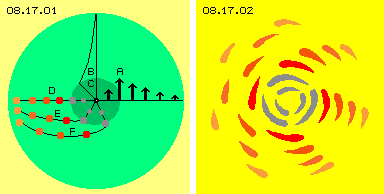 At A arrows are drawn in tangential direction, representing the speed of particles. From outside inward, the particles are moving in turning sense (here all times counter clockwise) by increasing angle-speed and also increasing absolute speed. At B this increasing speed is marked by a curve.
At A arrows are drawn in tangential direction, representing the speed of particles. From outside inward, the particles are moving in turning sense (here all times counter clockwise) by increasing angle-speed and also increasing absolute speed. At B this increasing speed is marked by a curve.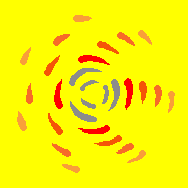 Similar motion processes occur at ecliptic, where the outer planets are overtaken by faster planet of each narrow track. However these ´particles´ are not in direct mutual contact (like particles of water or gases), but are flying at their circles within ´empty space´. So demanded pressure for bond within ecliptic (and even the inside acceleration of that vortex) must be caused otherwise. As attracting forces through nothing can not be assumed honestly (in spite of deep conviction of sciences), only the characteristic of an aetheric vortex can be responsible for.
Similar motion processes occur at ecliptic, where the outer planets are overtaken by faster planet of each narrow track. However these ´particles´ are not in direct mutual contact (like particles of water or gases), but are flying at their circles within ´empty space´. So demanded pressure for bond within ecliptic (and even the inside acceleration of that vortex) must be caused otherwise. As attracting forces through nothing can not be assumed honestly (in spite of deep conviction of sciences), only the characteristic of an aetheric vortex can be responsible for.
The aether by itself is stationary in principle and thus can not do far reaching rotating motions. The aether can only swing at minimum radius. Above this the aether does not exist by particles, which could glide along each other. That´s why neighbouring aether-points must move parallel to each other at great extent. However an asymmetric swinging of aether well is possible and finally this allows appearance of wide-range flows of material particles.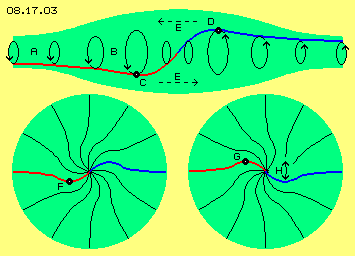 As soon as anywhere the aether is moving on wider tracks, necessarily that motion pattern of a ´double-crank´ (here of red and blue curve) comes up. This corresponds e.g. with axis of an electron (see ´Potentialvortexcloud´ at part ´02. Local Aether-Movements´). At atoms, such motion pattern are arranged radial within sphere-shapes (see chapter ´08.13. Aether-Model of Atoms´). When such double-cranks are arranged parallel to each other, flat pattern are given (like shown at chapter ´08.14. Faces, Pipes and Membranes´). Now here are discussed radial-flat arrangements in shape of discs (like really existing as milky-way, the ecliptic and as ´whirlpool´ of earth-system).
As soon as anywhere the aether is moving on wider tracks, necessarily that motion pattern of a ´double-crank´ (here of red and blue curve) comes up. This corresponds e.g. with axis of an electron (see ´Potentialvortexcloud´ at part ´02. Local Aether-Movements´). At atoms, such motion pattern are arranged radial within sphere-shapes (see chapter ´08.13. Aether-Model of Atoms´). When such double-cranks are arranged parallel to each other, flat pattern are given (like shown at chapter ´08.14. Faces, Pipes and Membranes´). Now here are discussed radial-flat arrangements in shape of discs (like really existing as milky-way, the ecliptic and as ´whirlpool´ of earth-system).
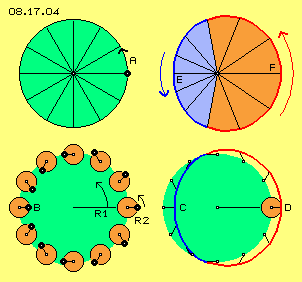 In reality, the Free Aether is moving on ´cluster-shaped´ tracks. Here at the two-dimensional pictures, these tracks simply are drawn as circles. An aether-point A (black) for example is moving around its fulcrum by 30 degree each time-unit (upside left at picture 08.17.04). Mostly that motion with radius R1 (green circle-face) is overlaid by second turning of radius R2 (red circle face). Below left at picture, thus twelve positions of observed aether-point (black) are marked.
In reality, the Free Aether is moving on ´cluster-shaped´ tracks. Here at the two-dimensional pictures, these tracks simply are drawn as circles. An aether-point A (black) for example is moving around its fulcrum by 30 degree each time-unit (upside left at picture 08.17.04). Mostly that motion with radius R1 (green circle-face) is overlaid by second turning of radius R2 (red circle face). Below left at picture, thus twelve positions of observed aether-point (black) are marked.
Opposite to previous material potential-vortices (of both first pictures), here won´t occur wide-running rotations. The aether in principle is stationary and is swinging only within its small ´frame of motions´. At picture 08.17.05 once more is drawn a view onto a vortex-disc, now however with the characteristics of an aether-potential-vortex.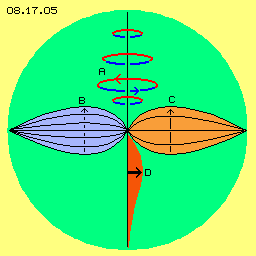 Cross to radial direction, previous circled tracks are arranged with increasing radius from outside inward (at A). Decisive is radius R2 of overlaid motion, because this determines the size of that stroke. The longer and faster sector again is marked red, the shorter and slower section of track is marked blue.
Cross to radial direction, previous circled tracks are arranged with increasing radius from outside inward (at A). Decisive is radius R2 of overlaid motion, because this determines the size of that stroke. The longer and faster sector again is marked red, the shorter and slower section of track is marked blue.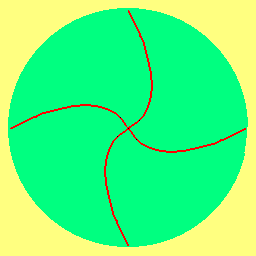 Illusion
Illusion
It´s clear, our six senses allow knowledge of a rather reduced section of reality. However the greatest illusion might be, we believe to live within a world of material particles. For example we drive a car build by solid parts and we observe racing motions of gigantic celestial bodies. Realiter nothing is moving forward within that unique existing substance of aether, which is only swinging somehow at its local place.
Atoms exist by just normal aether, which locally is only swinging by special pattern. Within the aether, many motions can overlay, for example all kind of radiations. These however can merely penetrate the atoms and the motions of atoms mutually can not overlay at all. At the other hand, atoms well react on motion pattern of surrounding aether.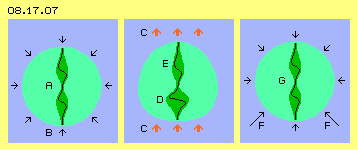 At previous chapters was described in extension, how motion pattern are shifted forward within space. So here that general process is shown once more only in brief. At C the upside discussed strokes are marked by red arrows. The below vortex D of atom becomes compressed to shorter length and thus becomes extended aside. That stroke practically occurs everywhere same time, so the upper vortex E has space to be stretched some longer. The whole vortex-complex of atom is deformed into an ´egg-shape´, below pressed flat and wide and upside pulled some longer and sharp (see light-green face).
At previous chapters was described in extension, how motion pattern are shifted forward within space. So here that general process is shown once more only in brief. At C the upside discussed strokes are marked by red arrows. The below vortex D of atom becomes compressed to shorter length and thus becomes extended aside. That stroke practically occurs everywhere same time, so the upper vortex E has space to be stretched some longer. The whole vortex-complex of atom is deformed into an ´egg-shape´, below pressed flat and wide and upside pulled some longer and sharp (see light-green face).
When ever an object enters ´gravity-field´ of the sun or the earth, data of its track are registered and forecast of further course is calculated according to Newton and Kepler. Mostly however the comet or asteroid behaves somehow strange. Differences must not be any ´nuisance elements´, but common model don´t match the reality - because there is no far-reaching gravity but only these strokes of motion within the ´whirlpools´.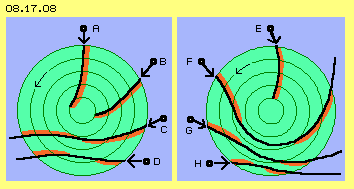 At A an object moves radial towards the center of vortex, however its flight is shifted towards right side (all times by view into direction of flight). So that track is different to forecast based on common gravity. At B the object enters by flat angle, contrary to turning sense of vortex. The thrust (red marked area) pushes the track towards right into center of vortex (like also the commonly supposed gravity would do). The ´headwind´ from left-front decelerates the speed of object (thus opposite to assumed gravity-acceleration).
At A an object moves radial towards the center of vortex, however its flight is shifted towards right side (all times by view into direction of flight). So that track is different to forecast based on common gravity. At B the object enters by flat angle, contrary to turning sense of vortex. The thrust (red marked area) pushes the track towards right into center of vortex (like also the commonly supposed gravity would do). The ´headwind´ from left-front decelerates the speed of object (thus opposite to assumed gravity-acceleration).
If a comet comes from that direction and passes the earth at the night-side (side opposite to sun), it will move at tracks shown at C or D. At first the ´headwind´ from aside-left pushes towards the earth. Some later that thrust comes from the other side (see sections marked red) and the track is pushed outward. At this S-shaped track the comet becomes little bit decelerated.
At F is marked the situation, where a ´space-vagabond´ comes near sun and its track is redirected within whirlpool of ecliptic. Analogue, the earth and neighbouring planets are used to accelerate satellites at their journey to outer planets via ´gravity-slinging´. At both cases the laws of astrophysics predict beautiful parabolic tracks.
Not every object crosses an aether-whirlpool but becomes ´captured´ within. That situation schematic is sketched at picture 08.17.09, where an object A (black) entered by acute angle into a left-beating aether-disc. As mentioned before, the flight-track at first is redirected towards right side (see red area of sideward thrust). Based on inertia, each object will move straight ahead within space. If the track of the object is curved, centrifugal forces come up respective there must exist a centripetal force for bending the track. Here the object was relative near to center, however moved onto wider circle-sections. Tracks out there are less curved and the centrifugal forces are weaker correspondingly. The object finally will swivel into a round track, where sideward push of aether-strokes is strong enough to compensate the centrifugal force.
Based on inertia, each object will move straight ahead within space. If the track of the object is curved, centrifugal forces come up respective there must exist a centripetal force for bending the track. Here the object was relative near to center, however moved onto wider circle-sections. Tracks out there are less curved and the centrifugal forces are weaker correspondingly. The object finally will swivel into a round track, where sideward push of aether-strokes is strong enough to compensate the centrifugal force.
´Worlds in Collision´ is the title of a book of Dr. Immanuel Velikovsky and some other authors (Sitchin, Lutze e.a.) also describe ´incredible scenarios´. At picture 08.17.10 schematic is sketched the situation when celestial bodies come nearby and the dramatic result. At first, at A is drawn a normal road (blue), where two vehicles (green and red points) are passing. Besides some turbulences of air, nothing happens (because particles of air are free to move anyway). When celestial bodies pass, the median strip (B, white) comparably should be at least half a kilometer - otherwise a catastrophe inevitably results (because the aether of their whirlpools can not move any kind).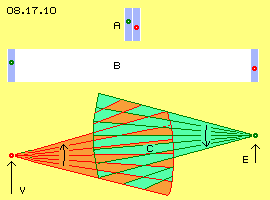 All aether probably is moving about speed of light or some faster. If contrary motions meet by acute angle, the crossing-points race through space by multiple light-speed, here towards right to the earth and same time towards left to the Venus (like steep waves of a ´crossing sea´). ´Electromagnetic thunderstorms´ rage within total space between these objects. The internal mobility respective bending-tolerance of gapless aether is strained by maximum. The oversized tension can relax only by motions racing off by extreme speeds.
All aether probably is moving about speed of light or some faster. If contrary motions meet by acute angle, the crossing-points race through space by multiple light-speed, here towards right to the earth and same time towards left to the Venus (like steep waves of a ´crossing sea´). ´Electromagnetic thunderstorms´ rage within total space between these objects. The internal mobility respective bending-tolerance of gapless aether is strained by maximum. The oversized tension can relax only by motions racing off by extreme speeds.
´Thunderstorms of immense forces were racing, water did run up mountains, the night didn´t end and at the other side the sundown was delayed, earth did break and vulcanic eruptions pushed off fire and ashes, whole continents were lifted or did sink, it rained for weeks, all grounds were devastated and many people died, especially at settlements near rivers and coasts, remaining humans could only survive because manna did fall from heaven, most cultures and civilizations were destroyed, mankind had to start practically just from zero-state.´
One of the scientific fix-points is the conviction of geology to assume long evolutionary processes and to exclude such short ´catastrophic´ events. Geological pieces of evidence are just not noted. For example, the depositions north of the Alps can never be build by normal erosion. The Mediterranean must have spilled over the mountains and has build up huge layers of debris. Bolders lay practically everywhere - at locations never a glacier could have them transported.
They did not feel these extreme motions, like we don´t feel something about our steady voyage through space. The astronomers watched calm their instruments. At the Middle East they stated by day and hour, when the sun did not sink in the west but did rise again. At Far East was registered and documented, how fix-stars did sway at heaven.
All aether-motions at that time were much more violent than at todays normal circumstances. During that meeting of earth and Venus and long times afterward, unsorted motion-fragments did race towards the earth. Already the outer layers of atmosphere were ionized - because an electron builds the most small, local ordered vortex-structure. If such ´double-cranks´ are asymmetric, wider balancing area is necessary, building the ´aura´ of the most small atom - a H-atom is born. If several of such vortices get together radial, vortex-complexes come up e.g. of atoms like C or O (see Chapter ´Aether-Model of Atoms´).
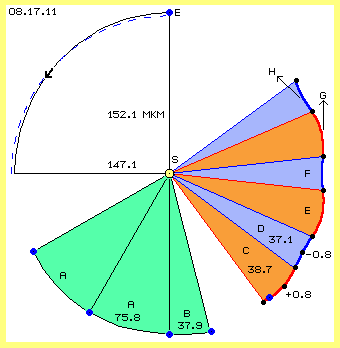 After that excursion into the past of the earth-whirlpool now actual data are discussed. At picture 08.17.11 at center is marked the sun (S, yellow), around which the earth (E, blue) rotates. The distance to sun is varying between about 152.1 and 147.1 million kilometer (Mkm). Thus the earth is tumbling around left-turning at a rather uneven track.
After that excursion into the past of the earth-whirlpool now actual data are discussed. At picture 08.17.11 at center is marked the sun (S, yellow), around which the earth (E, blue) rotates. The distance to sun is varying between about 152.1 and 147.1 million kilometer (Mkm). Thus the earth is tumbling around left-turning at a rather uneven track.
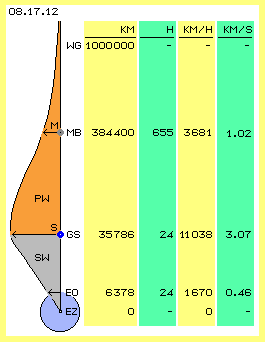 If far around the earth would exist huge clouds of dust, one could see the aether-movements as a gigantic whirlwind (and only by that meaning the terms ´wind´ respective ´flow´ are used at the following). Really existing are only few moving ´dust-particles´ for deduction of characteristics of the earth-whirlpool. Some data schematic are sketched respective listed at picture 08.17.12.
If far around the earth would exist huge clouds of dust, one could see the aether-movements as a gigantic whirlwind (and only by that meaning the terms ´wind´ respective ´flow´ are used at the following). Really existing are only few moving ´dust-particles´ for deduction of characteristics of the earth-whirlpool. Some data schematic are sketched respective listed at picture 08.17.12.
 At picture 08.17.13 a sector of ecliptic is sketched, representing the ´rotating sun-vortex-wind´ (SW, yellow). This is a potential-vortex with decreasing speeds from inside towards outside, e.g. moving at the Venus by about 35 km/s, at Mars by 24 km/s and between at area of the earth (E, blue) with some 30 km/s (see arrows).
At picture 08.17.13 a sector of ecliptic is sketched, representing the ´rotating sun-vortex-wind´ (SW, yellow). This is a potential-vortex with decreasing speeds from inside towards outside, e.g. moving at the Venus by about 35 km/s, at Mars by 24 km/s and between at area of the earth (E, blue) with some 30 km/s (see arrows).
If the earth would be stationary in space, the moon could drift around within that vortex at a circle-round track. However the moon´s motion is also affected by the ´sun-vortex-wind´ and thus its track is deformed. At picture 08.17.14 upside left this is shown by four phases. The blue curves represent circle-sections around the earth, the black arrows show the differing sections of moon-track.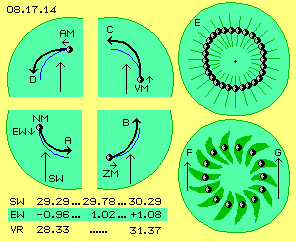 The moon´s ´swivel-track´ shown at previous picture 08.17.11 is composed by these differing phases. Thus the moon won´t move at a circle-shaped track around the earth, nor at an elliptic track. Also the speeds show great differences, like listed downside left at this picture:
The moon´s ´swivel-track´ shown at previous picture 08.17.11 is composed by these differing phases. Thus the moon won´t move at a circle-shaped track around the earth, nor at an elliptic track. Also the speeds show great differences, like listed downside left at this picture:
Upside right at this picture at E are drawn 28 positions of the moon, showing schematic the un-even track around the earth. Not only the moon-track but also the whole earth-vortex is deformed by the overlaying ´winds´, like marked by unequal disk. There are no mechanic exact motions, even better the process is comparable to air-flows: at the northern half-sphere of earth the air as a whole is moving from west to east. Embedded are left-turning areas of depressions, which never are perfect circled vortices. In general, also these air-movements are potential-vortices, however cold- and warm-fronts move by different speeds within.
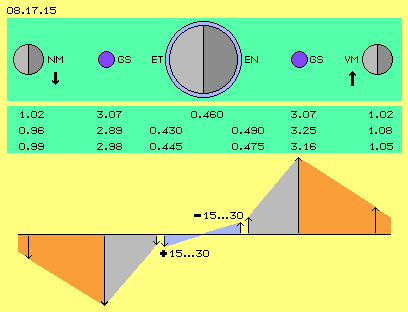 At picture 08.17.15 upside the relevant´ dust-particles´ are drawn at different positions: the moon left as new moon NM and right side as full moon VM, at the middle the earth with its day- and night-side ET respective EN, between two geostationary satellites GS. At row below the average speed of moon with 1.02 km/s, of satellites with 3.07 km/s and these 0.46 km/s of turning-speed at equator are listed.
At picture 08.17.15 upside the relevant´ dust-particles´ are drawn at different positions: the moon left as new moon NM and right side as full moon VM, at the middle the earth with its day- and night-side ET respective EN, between two geostationary satellites GS. At row below the average speed of moon with 1.02 km/s, of satellites with 3.07 km/s and these 0.46 km/s of turning-speed at equator are listed.
Before Einstein, some years after 1900, negated the existence of aether, many famous physicists vehemently discussed properties of ´light-aether´. One was not convinced about its consistence, whether it should exist only between materia or whether it´s pulled with the celestial bodies or whether it´s stationary and thus the earth should race through a resting fluid. It was also discussed whether the light-speed is constant or variable.
There are a high tide and a low tide about every twelve hours. The lift of tides varies by weekly rhythm, it´s relative small when moon is waxing or in the wane, it´s increasing at new moon and especially at full moon. So commonly is assumed, the tides are based on attracting force of the moon. This appearance exists all over the world, however by different size. For example the Golf-flow pressed through the Canal into the North Sea with tides up to ten meter. Opposite e.g. within the wide Pacific the tides are rather constant with medium tides of about only 1.5 m lifting height.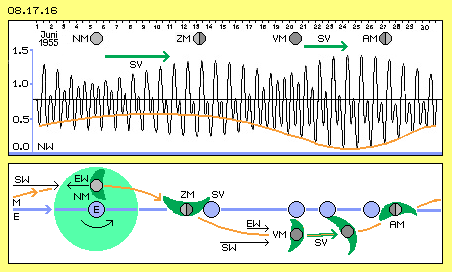 If one observes each highest water-level it´s clear to state, maximum swinging is not at new moon, but finally short time before half-moon. Likely delay of about tree to four days has the highest tide near full moon. That ´spring-tide-delay´ (SV, see green arrows) is given worldwide - and is not to explain by any supposed attracting forces of moon or the sun or any other deviation of gravity by different masses of earth.
If one observes each highest water-level it´s clear to state, maximum swinging is not at new moon, but finally short time before half-moon. Likely delay of about tree to four days has the highest tide near full moon. That ´spring-tide-delay´ (SV, see green arrows) is given worldwide - and is not to explain by any supposed attracting forces of moon or the sun or any other deviation of gravity by different masses of earth.
The appearance of tides never ever can be based on gravity, no matter how often it´s told and repeated. The tides result of interaction of aether-whirlpools of sun and the earth, like schematic sketched at this picture below.
At picture 08.17.17 left side is sketched, why the characteristic of tides is so different. The earth E is moving upward, driven by sun-wind SW. The day-side T of earth thus is positioned left, the night-side N at right side. The earth-aether-vortex is left-turning and like discussed upside at picture 08.17.15, the wind at night-side is much stronger with maximum 0.49 km/s than at the day-side with minimum 0.43 km/s (see arrows).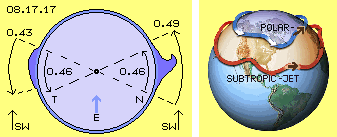 The earth rotates with its constant 0.46 km/s (at equator). So at right side, the earth is too slow, i.e. there the faster ´aether-wind´ lashes up high sea-waves. Opposite at left side, the earth is too fast relative to the slow ´aether-wind´. That wind keeps the waters back respective the earth ´submerges the waters´. So at the sun-side occurs only a relative soft lifting of water-level, which in addition achieves the maximum finally with some delay.
The earth rotates with its constant 0.46 km/s (at equator). So at right side, the earth is too slow, i.e. there the faster ´aether-wind´ lashes up high sea-waves. Opposite at left side, the earth is too fast relative to the slow ´aether-wind´. That wind keeps the waters back respective the earth ´submerges the waters´. So at the sun-side occurs only a relative soft lifting of water-level, which in addition achieves the maximum finally with some delay.
Ten to fifteen kilometers above, real winds are racing, the jet-streams, which can not be explained by pure meteorological view. At previous picture 08.17.17 right side the general ways of these air-flows schematic are sketched: between 40 and 60 degree of latitude the polar-jetstreams are roaring and again between 20 and 30 degree of latitude the subtropical-jetstreams ´meander´ around the globe. These winds achieve remarkable speeds of 200 up to 500 km/h.
At picture 08.17.18 upside once more the earth E (light-blue) is drawn, turning around its axis, at equator with these roundabout 0.46 km/s (see blue arrows). The sun-wind SW again is directed upward, so at right (night-) side the ´aether-wind´ sweeps across the earth-surface up to 0.49 km/s (see green arrow). At the sun-side (left) that relative flow is reduced at about 0.43 km/s (see red arrow).
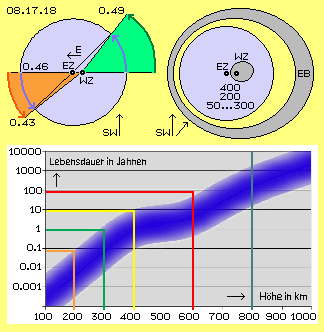 The strokes of aether-motions build a rigid vortex at least up to geostationary satellites. Nevertheless it won´t move like a rigid wheel with a radius of 40 000 km and anywhere likely angle-speed. This whirlpool however moves like a water-vortex or tornado with a ´trunk´ tumbling around the center. So it´s most probable, that vortex-center WZ will swivel around within an area (marked dark grey). All times the earth-center EZ is positioned left side (towards sun), the actual vortex-center WZ some 50 to 300 km further right (night side).
The strokes of aether-motions build a rigid vortex at least up to geostationary satellites. Nevertheless it won´t move like a rigid wheel with a radius of 40 000 km and anywhere likely angle-speed. This whirlpool however moves like a water-vortex or tornado with a ´trunk´ tumbling around the center. So it´s most probable, that vortex-center WZ will swivel around within an area (marked dark grey). All times the earth-center EZ is positioned left side (towards sun), the actual vortex-center WZ some 50 to 300 km further right (night side).
A further indicator for previous claims concerning aether-whirlpool of earth is the ´life-expectancy´ of space-garbage. Ten thousands fragments drift around the earth, more than thousand ´dangerous´ parts are observed steady. Below at this picture 08.17.18 an official graph shows, how long at which height these parts probably will remain. I did only highlight some lines to point out the message.
A perfect equilibrium between centrifugal- and gravity-forces exists at a geostationary satellite, which in addition is turning synchronous to the earth. Dish-antenna are directed fix to its position and thus all times we are up to date concerning supply of communication-media. The physical bases for installation of a geostationary satellite is quit easy, like schematic sketched at picture 08.17.19 left side.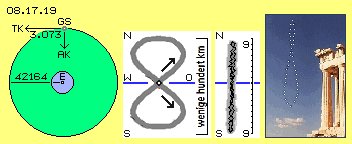 Unfortunately the reality completely contradicts known and clear theory: without controlling measurements the satellites every day are ´dancing´ at 8-shaped tracks or sway once from north to south and back again (see grey tracks at middle of picture). This steady divergences from pretended positions above the equator (blue line) are ´only few hundred kilometer´ or maximum ´only ten degree´. Even worse is the fact, there are only four locations above equator, where satellites keep fairly well stabile or at least geosynchronous positions.
Unfortunately the reality completely contradicts known and clear theory: without controlling measurements the satellites every day are ´dancing´ at 8-shaped tracks or sway once from north to south and back again (see grey tracks at middle of picture). This steady divergences from pretended positions above the equator (blue line) are ´only few hundred kilometer´ or maximum ´only ten degree´. Even worse is the fact, there are only four locations above equator, where satellites keep fairly well stabile or at least geosynchronous positions.
There is a similar appearance at sky, in shape of the ´Analemma-curve´: if the position of the sun is stated at one geographic location each day at likely universal-time, the sun-positions build an 8-shaped curve (see right side of picture). The up-and-down results of inclination of earth-axis to the ecliptic. The forward-and-backward result of elliptic track of earth and thus (by Kepler-law) the varying speed. In addition the sun is positioned eccentric to earth-track (alleged at the focus of ellipse - if that spot could be defined for an uneven track). In the (north-) winter, the earth is most near to sun (however finally at 2. January, while mid-winter is already at 21.December). At this time, the earth is flying relative fast and thus the winter-half is one weak shorter than the summer-half. In summer the earth is positioned most far from sun, again some days after midsummer.
At picture 08.17.20 schematic are shown some graphs for easy explaining previous unsolved problems. Upside left geostationary satellites (GS, grey points) are drawn at diverse positions. By common understanding they should turn around the earth (E, blue) by constant angle-speed, thus moving likely distances each time-unit. However these satellites are not fix connected via ´spokes´ with the earth and the turning does not occur like a rigid wheel (with its mechanical conformity). At the other hand the satellites do not move only within an ´empty space´.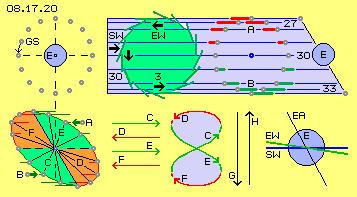 The earth is pushed forward within space by these average 30 km/s all times. When a satellite momentary is positioned between earth and sun, it moves forward within space much slower. At the night-side it flies forward correspondingly faster. Naturally the scales at this picture are extremely overdrawn. The earth e.g. flies forward about 2600000 km every day. The satellite phasewise stays back or is running ahead by about 40000 km. During twelve hours thus the satellite moves forward 1340000 km or only 1260000 km. Strong overdrawn thus is also the relative-motion below left of picture.
The earth is pushed forward within space by these average 30 km/s all times. When a satellite momentary is positioned between earth and sun, it moves forward within space much slower. At the night-side it flies forward correspondingly faster. Naturally the scales at this picture are extremely overdrawn. The earth e.g. flies forward about 2600000 km every day. The satellite phasewise stays back or is running ahead by about 40000 km. During twelve hours thus the satellite moves forward 1340000 km or only 1260000 km. Strong overdrawn thus is also the relative-motion below left of picture.
When the satellite in the general flow momentary stays behind, it is positioned (at this picture) left from the earth (respective stands there at the evening). Afterward it reaches the area of faster flow, thus becomes accelerated, like marked below-left at B. The acceleration goes on until it stands cross (within general flow) to the earth (at midnight). The satellite overtakes (right side in drive-direction) the earth, which still is drifting forward by constant speed. Relative to steady rotation of earth, the satellite seems to wander forward to the east. This sector C of accelerated motion of satellite is marked light-green.
Thus are resulting these motions of geostationary satellites into west-east and east-west direction. The north-south motion (and back again) are simply explained, like sketched at this picture below right side. The ecliptic here is drawn as blue line of sun-whirlpool SW. Relative to that plane the earth-axis EA is inclined about 23 degree. The earth-whirlpool EW here is drawn as green line, relative to the ecliptic inclined by about five degree. A geostationary satellite does not move along the equatorial plane (as the common theory demands), but to a great extent at plane of earth-whirlpool (like the moon, however by limited size, see below).
The Analemma-curve of sun is based on likely causes: within aether-whirlpool of galaxy the sun-whirlpool is embedded as a diagonal border-vortex (so that wind does not blow necessarily tangential to galactic center). Also there, the vectors of both ´winds´ are overlaying, so the earth alternately is drifting faster and again slower through space (however at other times than theoretic assumed by supposed general validity of Kepler-laws). Like situation of geostationary satellites, the earth overtakes the sun and opposite is overtaken by the sun, while both are drifting through space.
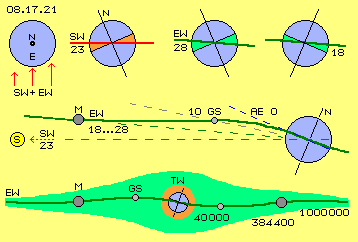 At picture 08.17.21 upside-left once more the earth E (blue) is drawn by view onto the north-pole N. As the ´aether-winds´ of sun and earth mutually overlay, the earth is pushed forward by different pressures (see arrows SW + EW). Like each gyroscope the earth-axis swerves right-angle to, like sketched aside. Between plane of ecliptic (red line SW) and plane of equator results that angle of about 23 degree (red sectors). The earth-axis stands relative stiff within space, at the one hand based on earth-inertia, at the other hand their inclination is determined by superior strength of ´galactic aether-wind´ (here however not relevant).
At picture 08.17.21 upside-left once more the earth E (blue) is drawn by view onto the north-pole N. As the ´aether-winds´ of sun and earth mutually overlay, the earth is pushed forward by different pressures (see arrows SW + EW). Like each gyroscope the earth-axis swerves right-angle to, like sketched aside. Between plane of ecliptic (red line SW) and plane of equator results that angle of about 23 degree (red sectors). The earth-axis stands relative stiff within space, at the one hand based on earth-inertia, at the other hand their inclination is determined by superior strength of ´galactic aether-wind´ (here however not relevant).
At the row below at picture, a cross-sectional view through the complete earth-vortex-disc is sketched. Instead of previous straight lines, now the earth-whirlpool is drawn as a S-shaped curve (see thick green curve EW). That earth-vortex has not only a flat extension (like up to now was drawn), but naturally the aether upside and below must show analog stroke components. This area is marked light-green.
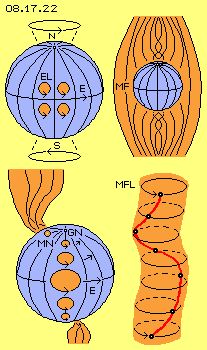 That turning around an axis of changing positions and within a curved vortex-disc has two essential consequences, which schematic are sketched at picture 08.17.22. Upside was mentioned an example of wooden sphere rotating within water (with tumbling axis). At and nearby the sphere-surface naturally come up water layers with multiple small vortices. Analogue is the situation direct at surface of earth E (light blue), which is rotating with constant revolutions (see arrows at equator), however not anywhere congruent to the ambient medium, already based on that seasonal swinging of axis (see circled arrows at N and S).
That turning around an axis of changing positions and within a curved vortex-disc has two essential consequences, which schematic are sketched at picture 08.17.22. Upside was mentioned an example of wooden sphere rotating within water (with tumbling axis). At and nearby the sphere-surface naturally come up water layers with multiple small vortices. Analogue is the situation direct at surface of earth E (light blue), which is rotating with constant revolutions (see arrows at equator), however not anywhere congruent to the ambient medium, already based on that seasonal swinging of axis (see circled arrows at N and S).
At this picture below-left one more cause for disturbances of aether at environment near the earth is shown. The earth E (blue) is turning by constant angle speed, depending on latitude however the absolute speeds are very different (at equator about 0.5 km/s and at the poles practically zero, here represented by arrows and red circles of different diameter. Also these differences must be bridged by varying strokes of aether-movements. These divergences can not be balances simple by the thin layer of previous electrostatic charge direct at earth-surface. However equalizing motions are necessary, reaching up to heights of 60000 or even 600000 km.
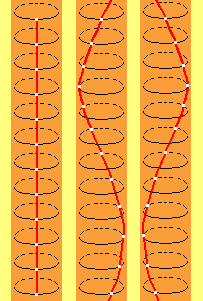 At this animation once more are shown three magnet-field-lines and their movements are visualized. The white spots represent observed aether-points and the red connecting lines represent neighbouring aether-points between. Left side of picture, all aether-points swing left-turning and similar. Also the aether aside of (here not shown) is swinging parallel to. Many of these neighbouring ´threads´ build a ´magnetic field´ - at this neutral shape however without polarization.
At this animation once more are shown three magnet-field-lines and their movements are visualized. The white spots represent observed aether-points and the red connecting lines represent neighbouring aether-points between. Left side of picture, all aether-points swing left-turning and similar. Also the aether aside of (here not shown) is swinging parallel to. Many of these neighbouring ´threads´ build a ´magnetic field´ - at this neutral shape however without polarization.
The characteristic of total aether-whirlpool of earth upside was deduced by motions of some ´dust-particles´. Also these relative ´fine´ motion-pattern of earthly magnetfield becomes visible only by particles - which steady are flying from the sun towards the earth. That flow e.g. results known appearance of polar-lights. Picture 08.17.24 upside shows especially striking the rolling-in of vortex-´trunk´ within magnetfield of polar regions.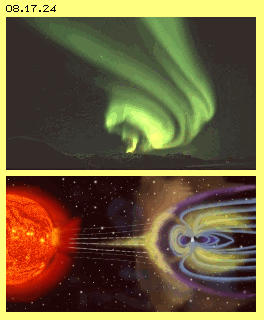 The earth-aether-vortex thus is a potential-vortex in its outer regions, passing into a rigid vortex at heights probably near magnetopause. At least at height of geostationary satellites, the strokes of aether-swinging are linear reduced down to the earth-surface. So generally should exist calm motions within that inner area of rigid vortex. However previous local differences must be bridged and equalized, so quite turbulent vortices are resulting (well comparable to border-layers within water-flows).
The earth-aether-vortex thus is a potential-vortex in its outer regions, passing into a rigid vortex at heights probably near magnetopause. At least at height of geostationary satellites, the strokes of aether-swinging are linear reduced down to the earth-surface. So generally should exist calm motions within that inner area of rigid vortex. However previous local differences must be bridged and equalized, so quite turbulent vortices are resulting (well comparable to border-layers within water-flows).
Picture 08.17.25 upside shows a graph of ´official source´, where I only did colour different areas. At such graphs is assumed, the earth would function similar to a permanent-magnet (an absolute absurd idea, e.g. simply because of high temperatures of suggested iron-core). Alternative it´s assumed the earth-magnetism would function anyhow similar to an (inductive-) coil.
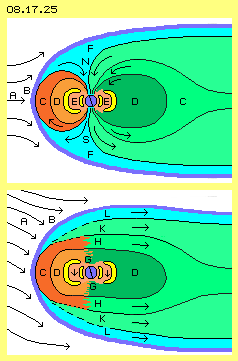 Because common sciences assume the earth-magnetism would work analogue to permanent-magnets or to electric current, ´naturally´ are suggested the magnetic-field-lines are closed and thus inevitably a dipole is alleged. Both is basically wrong (and just these months first time is discussed about ´uni-polar´ magnetic appearances at other connections). This example once more shows, how given ideas and models limit the view and hinder insights of true facts.
Because common sciences assume the earth-magnetism would work analogue to permanent-magnets or to electric current, ´naturally´ are suggested the magnetic-field-lines are closed and thus inevitably a dipole is alleged. Both is basically wrong (and just these months first time is discussed about ´uni-polar´ magnetic appearances at other connections). This example once more shows, how given ideas and models limit the view and hinder insights of true facts.
At previous animation were shown a neutral and a downward and an upward directed magnetfield-line. They differ only by the temporary shifted swinging motions. That swinging must not all times be conform (like simplistic drawn upside). As a rule this will also be swinging-with-stroke, e.g. caused by previous gusts. Neighbouring and likely swinging aether-points build common magnetfields. However also fields of different swinging can be neighboured, practically building a ´sandwich´ at a local area. A vortex-tail temporary can even be embedded within a contrary swinging vortex-bundle, so no clear polarization can be detected. The previous apex for example will not stay at a fix position, but that differing ´upside-over-north-pole´ or ´below-crossing-south-pole´ will change depending of actual ´wind-conditions´. Analogue also the thinned-out areas of night-side might show varying polarization.
I only can state as a claim these considerations concerning earthly magnetic-field and I have no data for approval. Nevertheless these hypothesis might fit better to reality than common models - because todays favorite theories show lots of contradictions and thus by sure can not work and mostly have really no explanation for previous discussed phenomena.
08.18. Aether-Physics of Sun
08. Something Moving